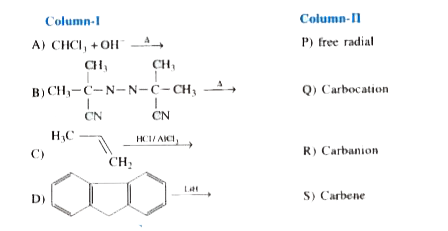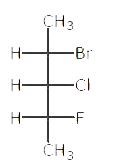In order that a compound may show geometrical isomerism
A Compound must have a chiral carbon
(B) Each of the two doubly bonded carbon atoms must have different atoms or groups
(C ) Compound must have a plane of symmetrySolution in Telugu
only A
only B
only C
None
The correct Answer is:B
Step by step video, text & image solution for In order that a compound may show geometrical isomerism A Compound must have a chiral carbon (B) Each of the two doubly bonded carbon atoms must have different atoms or groups (C ) Compound must have a plane of symmetry by Chemistry experts to help you in doubts & scoring excellent marks in Class 11 exams.
Topper's Solved these Questions
- BOOK - AAKASH SERIESCHAPTER - GENERAL ORGANIC CHEMISTRYEXERCISE - Objective Exercise -282videos
GENERAL ORGANIC CHEMISTRY
- BOOK - AAKASH SERIESCHAPTER - GENERAL ORGANIC CHEMISTRYEXERCISE - Practice Exercise80videos
GENERAL ORGANIC CHEMISTRY
- BOOK - AAKASH SERIESCHAPTER - GENERAL ORGANIC CHEMISTRYEXERCISE - Subjective Exercise -8120videos
GENERAL ORGANIC CHEMISTRY
- BOOK - AAKASH SERIESCHAPTER - ENVIRONMENTAL CHEMISTRYEXERCISE - EXERCISE ON PASSAGE (PASSAGE-III)5videos
ENVIRONMENTAL CHEMISTRY
- BOOK - AAKASH SERIESCHAPTER - HYDROCARBONSEXERCISE - ADDITIONAL PRACTICE SHEET ( LEVEL-II (PRACTICE SHEET (ADVANCED) (MATRIX MATCHING TYPE QUESTIONS)))5videos
HYDROCARBONS
Similar Questions
The compound containing sp sp2 and sp3 hybridised carbon atoms in 1:2:3 ratio is
01:36View SolutionThe compound CH3−CH∣CH3−CH∣CH3−CH3 contains
View SolutionExplain the estimation of nitrogen of an organic compound by
(a) Dumas method and (b) Kjeldahl's method02:38View SolutionOzone layer acts as one of the most important life support system. The major cause of ozone layer destruction is believed to be the release of chlorofluorocarbon compounds. UV radiation causes the chlorofluouocarbons to dissociate : CF2Clhv−−→Cl⋅+CF2CI A highly reactive chlorine atomis responsible for the decomposition of ozone. Cl⋅+O3(g)→ClO⋅+O2(g)ClO⋅+O(g)→Cl⋅+O2(g) Free radicals of chlorine decompose ozone molecules in a chain reaction. The depletion of ozone layer leading to ozone hole has, however, been mainly observed in the stratosphere over Antarctica. Special type of cloud called polar stratospheric colouds are formed over Antarctica.These clouds (contain solid HNO3.3H2O) play an important role in ozone depletion.
ClO⋅+NO2→ClONO2
ClONO2+H2O→HOCl+HNO3
ClONO2+HCl→Cl2+HNO3
HOClhv−−→HO⋅+Cl⋅
The reactive chlorine atoms thus formed are rendered to deplete ozone layer.
The ozone layer is present in :02:38View SolutionMatch the intermediates formed in the reaction.
 05:24View Solution
05:24View SolutionAssertion A molecule containing chiral carbon must be non-superimposable on its mirror image. ltbr> Reason A chiral carbon is bonded to four different atoms or groups.
06:06View SolutionWhat is the minimum number of carbon atoms of an alkane must have to form an isomer?
View SolutionCarbon forms a large number of compounds because of its two unique properties formed many have long straight chains of carbon, branched chains of carbon or rings of carbon. In these compounds, carbon atoms may form single, double or triple covalent bonds. Compounds in which the carbon atoms are linked to each other by single bonds are called saturated carbon compounds whereas compounds having at least one carbon-carbon double or triple bond are called unsaturated carbon compounds. Compounds containing only carbon and hydrogen are known as hydrocarbons. Based on the above information, answer the following questions.
Give two examples of carbon compounds which have ring structure.03:19View SolutionCarbon forms a large number of compounds because of its two unique properties formed many have long straight chains of carbon, branched chains of carbon or rings of carbon. In these compounds, carbon atoms may form single, double or triple covalent bonds. Compounds in which the carbon atoms are linked to each other by single bonds are called saturated carbon compounds whereas compounds having at least one carbon-carbon double or triple bond are called unsaturated carbon compounds. Compounds containing only carbon and hydrogen are known as hydrocarbons. Based on the above information, answer the following questions.
Give two examples of carbon compounds which have ring structure.07:50View SolutionIf a molecule contains one carbon atom carrying four different groups it will not have a plane of symmetry and must therefore be chiral. A carbon atom carrying four different groups is a steregoenic or chiral centre. A structure with a plane of symmetry is achiral and superimposable on its mirror image and cannot exist as two enantiomer. A structure without a plane of symmetry is chiral and not superimposable on its mirror image and can exist as two enantiomer.

Number of enantiomeric pairs are05:45View SolutionIf a molecule contains one carbon atom carrying four different groups it will not have a plane of symmetry and must therefore be chiral. A carbon atom carrying four different groups is a steregoenic or chiral centre. A structure with a plane of symmetry is achiral and superimposable on its mirror image and cannot exist as two enantiomer. A structure without a plane of symmetry is chiral and not superimposable on its mirror image and can exist as two enantiomer. Relation between (a) & (b) is
03:14View SolutionIf a molecule contains one carbon atom carrying four different groups it will not have a plane of symmetry and must therefore be chiral. A carbon atom carrying four different groups is a steregoenic or chiral centre. A structure with a plane of symmetry is achiral and superimposable on its mirror image and cannot exist as two enantiomer. A structure without a plane of symmetry is chiral and not superimposable on its mirror image and can exist as two enantiomer.
Compound has both center of symmetry and P.O.S02:17View Solutionisomera of a compound must have
03:10View SolutionThe parent chain must include carbon-carbon multiple bonds present in the compound
03:08View Solutionज्यामितीय समावयवता (Geometrical isomerism) इस प्रकार की समावयवता मुख्यत: वे यौगिक प्रदर्शित करते हैं, जिनमें कार्बन-कार्बन द्वि-बन्ध
 उपस्थित होता है तथा द्वि-बन्ध बनाने वाला प्रत्येक कार्बन परमाणु दो भिन्न परमाणुओं या समूहों से जुड़ा होता है। अतः “वह समावयवता जो द्वि-बन्ध युक्त कार्बन परमाणुओं से जुड़े हुए परमाणुओं या समूहों के भिन्न विन्यासों के कारण होती है, ज्यामितीय समावयवता कहलाती है।
उपस्थित होता है तथा द्वि-बन्ध बनाने वाला प्रत्येक कार्बन परमाणु दो भिन्न परमाणुओं या समूहों से जुड़ा होता है। अतः “वह समावयवता जो द्वि-बन्ध युक्त कार्बन परमाणुओं से जुड़े हुए परमाणुओं या समूहों के भिन्न विन्यासों के कारण होती है, ज्यामितीय समावयवता कहलाती है।
जब समान परमाणु या समूह, द्वि-बन्ध के एक ओर होते हैं, तो उसे समपक्ष रूप (cis-form) कहते हैं तथा जब समान परमाणु या समूह, द्वि-बन्ध के विपरीत ओर होते हैं, तो उसे विपक्ष रूप या विपक्ष समावयवी (trans-form या trans isomer) कहते हैं। इस प्रकार, ज्यामितीय समावयवता को समपक्ष-विपक्ष समावयवता (cis-trans isomerism) भी कहते हैं।
निम्न में से कौन-सा यौगिक ज्यामितीय समावयवता प्रदर्शित करेगा?View Solution

